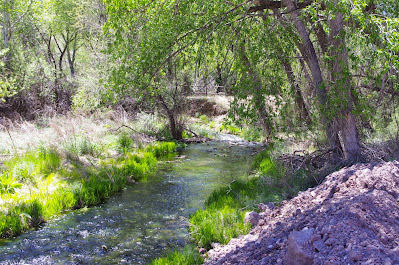Gila National Forest - Lake Roberts Slot Canyons (south side), " Box Elder Canyon"

I spent only short time obsessing about the time wasted climbing up to the ridge twice only to come back down into the same canyon. Blame it on hasty research. When I got back home to check the maps and Google Earth, I could see very clearly the side canyon I climbed up initially did not head west at all, but paralleled the main channel of Dam Canyon heading south. My brain had been rotated a full 90 degrees from my body. Luckily, my research, however hasty, had a back-up plan. I headed back out to NM 35, drove around the lake and through a little neighborhood of old summer cabins and small homes on a hill on the south side of Sapillo Creek. At the back of this development, at the top of a small mesa, was a dirt road onto Forest Service land. I drove it for less than a mile, parked, and off we went down into the canyon to the west, which I'm dubbing Box Elder Canyon for the abundance of this tree growing down amongst its shady walls.

This canyon was bit smaller, but had running water as well. It was also narrower, with the walls of conglomerate closing in sooner, the cliffs weren't particularly high at first, nor straight up on both sides of the canyon like a true slot. But after about 40 minutes of walking, the lush canyon, with not only box elder, but also alder, willow, gambel oak, locust, grapevine and yellow columbine transformed as the canyon sides soared upward, 50, 60 70, to over a 100 feet, into a gorge of nearly bare rock where the sunlight was pouring in. Each twist alternated dark and light. At one turn we came upon a small pool at the bottom of small muddy waterfall.

Now deep in the shade, we rested a bit, as I determined that this one would be climbed. I led the way skirting the muddy sides, Seamus followed, and we were both up easily. We walked the narrow passage and soon came upon two car sized boulders lodged in between the canyon walls at another small cascade. There was room to go under and between them. It was a bit slippery, but we both made it up quickly. Now we were in a more open, though still deeply shady area, where a large side canyon came in from the west. Large oak and box elder filtered the afternoon sun into gold. This seemed a secret, magical place to me. A hidden place where creatures of myth and fantasy might retreat to . . . So I was bit surprised when I spied three rusty metal hoops, the kind that go around an old wooden barrel, laying on the ground. Nearby, I saw a rusty iron pipe emerging from the sand as well. Hmm.


This canyon was bit smaller, but had running water as well. It was also narrower, with the walls of conglomerate closing in sooner, the cliffs weren't particularly high at first, nor straight up on both sides of the canyon like a true slot. But after about 40 minutes of walking, the lush canyon, with not only box elder, but also alder, willow, gambel oak, locust, grapevine and yellow columbine transformed as the canyon sides soared upward, 50, 60 70, to over a 100 feet, into a gorge of nearly bare rock where the sunlight was pouring in. Each twist alternated dark and light. At one turn we came upon a small pool at the bottom of small muddy waterfall.



I went on a short ways further. A fin of conglomerate protruded in the middle of the passage, beyond which two gigantic boulders blocked it altogether. There may have been a way to climb over, or around, but not through this time. It had been a long day for both us, and we would not get to see what the upper canyon held on this trip. We headed back down without incident and with several rests for my tired pup. I was happy to have another dose of Gila enchantment vibrating within.
Labels: hiking
















































